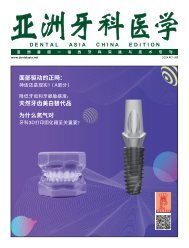Clinical Feature been planned and executed concurrently bring about a fast treatment result (Fig. 7). Case 1i Case 1g-i: Post-treatment photograph during retention period with minimal relapse Case 1c Fig. 8a: Pre-treatment models showing excessive overbite in a Class II Division 2 patient Case 1a-c: Pre-treatment models of a Class II Division 1 patient with 100% overbite Fig. 8b: Orthodontic effect of V-bend’s biteopening mechanics in both arches. Note locations of additional V-bends distal to lateral incisors on maxillary and mandibular 0.016”X0.22” NiTi archwires (arrows) that brought about this effect Case 1d: Intraoral photograph showing that the V-bends have intruded the maxillary incisors enough to bond mandibular incisors Case 2a Fig. 8c: Post-treatment frontal intraoral photograph of the same patient Patient treatments The following are cases with severe overbites treated by this V-bend technique. DA Case 1e: Effect of simultaneous V-bends on a 0.16”X0.022” NiTi mandibular archwire that over corrected the overbite Case 2b Case 1f: Last stage of treatment where normal overbite and overjet relation are restored Case 1a Case 1g Case 2c Case 2a-c: Pre-treatment models of a Class II Division 2 patient with severe overbite Case 1b Case 1h Case 2d 36 DENTAL ASIA MAY / JUNE <strong>2020</strong>
Clinical Feature Case 2e Case 2f Case 2d-f: Post-treatment frontal intraoral photographs of the same patient treated by the V-bends technique for bite opening. Normal overbite and overjet relations were restored nicely, but the tooth size discrepancy did not allow normal canine relations to be achieved References 1. Khouri, S.A., A solution for distal end bending of super elastic wires. Am J. Orthodon Dentofacial Orthop, 1998. 114: p. 675-676. 2. Khouri, S.A., Using the bendistal pliers for the correction of common orthodontic problems. World J. Orthod, 2002. 3(2): p. 172-174. 3. Burstone, C.R., Deep overbite correction by intrusion. Am J. Orthodon Dentofacial Orthop, 1977. 72(1): p. 1-22. 4. Mahoney, D.R., Witzeg, J.A., A modification of the twin block technique for patients with a deep bite. Functional Orthodon, 1999. 10(April-<strong>June</strong>): p. 4-8. 5. Demisch, A., Ingervall, B, Thur, U., Mandibular displacement in Angle Class II division 2 malocclusions. Am J. Orthodon Dentofacial Orthop, 1992. 102(6): p. 509-518. 6. Delair, J., Sagittal splitting of the body of the mandible (Mehmet’s technique) for correction of open bite and deep over bite. J. Maxillofac Surg, 1977. 5(2): p. 142-145. 7. Hinkle, F.G., Surgical treatment of adult Class II division 2 malocclusion. Am J. Orthodon Dentofacial Orthop, 1989. 95(3): p. 185-191. 8. Piecuch, J.F., Tideman, H., Correction of deep bite by total mandibular osteotomy; report of a case. J Oral Surg., 1981. 39(8): p. 601-606. 9. Bell, W.H., Jacobs, J.D., Legan, H.L., Am J. Orthodon Dentofacial Orthop, 1984. 85(1): p. 1-20. 10. Cooke, M.S., Wreakes, G., Upper torque/ intrusion mechanics in deep bite cases using the upper utility wire and directional headgear. Br. J. Orthod., 1979. 6(3): p. 157-161. 11. Shroff, B., Lindauer, S.J., Burstone, C.J., Leiss, J.B., Segmented approach to simultaneous intrusion and space closure: biomechanics of the three-piece base arch appliance. Am J. Orthodon Dentofacial Orthop, 1995. 107(2): p. 136-143. 12. Davidovitch, M., Rebellato, J., Two-couple orthodontic appliance systems utility arches: a two-couple intrusion arch. Semin Orthod, 1995. 1(1): p. 25-30. 13. Dake, M.L., A comparison of Ricketts and Tweed-type arch leveling techniques. Am J. Orthodon Dentofacial Orthop, 1989. 95(1): p. 72-78. 14. Nanda, R., Correction of deep bite in adults. Dent Clin North Am, 1997. 41(1): p. 67-87. 15. Melsen, B., Konstantellos, V., Lagoudakis, M., Planet, J., Combined intrusion and retraction generated by cantilevers and helical coil. J Orofac Orthop., 1997. 58(4): p. 232-241. 16. Sander, F.G., Wichelhaus, A. Scheimann, C., Intrusion mechanics according to Burstone with the NiTi-SE-steel uprighting spring. J Orofac Orthop., 1996. 57(4): p. 210-223. 17. Nanda, R., Marzban, R., Kulberg, A., The Connecticut Intrusion Arch. J Clin Orthod, 1998. 32(12): p. 708-715. 18. Molligan T F, Molar Control Part 1. J Clin. Orthod. 2002 Jan; 36 (1): 11-23 19. Hans, G.M., Kishiyama, C., Parker, S.H., Wolf, G.R., Noachtar, R., Cephalometric evaluation of two treatment strategies for deep bite correction. Angle Orthod, 1994. 64(4): p. 265-276. 20. Parker, C.D., Nanda, R.S., Currier, C.F., Skeletal and dental changes associated with the treatment of deep bite malocclusion. Am J. Orthodon Dentofacial Orthop, 1995. 107(4): p. 382-393. 21. Burstone, C.J., and Koenig, H.A. Creative wire-The force system from step and V-bends. Am J Orthod 1988; 93:59-67. 22. Lopez, I Goldberg, J., and Burstone, C.J. Bending characteristics of Nitinol wire. Am J Orthod 1979; 75: 569-575. 23. Tran, P.H., The three-tooth problem: a facial plane force system delivered by a gabled archwire segment. Master degree theses 2004 About the Authors Dr Suhail Khouri graduated from a postgraduate programme in orthodontics at the University of Connecticut in the United States in 1980. He taught and practiced orthodontics at Riyadh University’s dental college and King Faisal specialist hospital in Saudi Arabia until 1988. He became a Diplomat of the American Board of Orthodontics in 1988, and maintained an orthodontic private practice in Saint Louis, Missouri until 2015. His biomechanical clinical research had resulted in the development of the Bendistal Pliers in 1995, and Omni Pliers in 2015. Dr. Derek Mahony is a diplomate of the International Board of Orthodontics and a visiting clinical professor at the City of London <strong>Dental</strong> School in charge of their international orthodontic programme. He is a world-renowned specialist orthodontist who has spoken to thousands of practitioners about the benefits of interceptive orthodontic treatment. Dr. Mahony approaches his orthodontic diagnosis from a “facial profile” point of view. He sets his treatment goals to create not just straight teeth, but beautiful faces and healthy temporomandibular joints. MAY / JUNE <strong>2020</strong> DENTAL ASIA 37


















